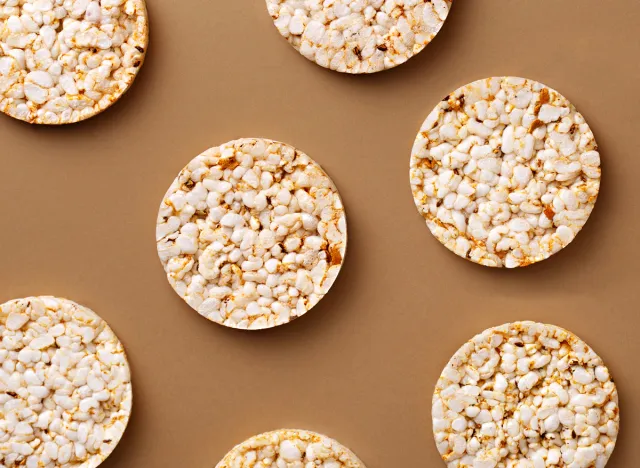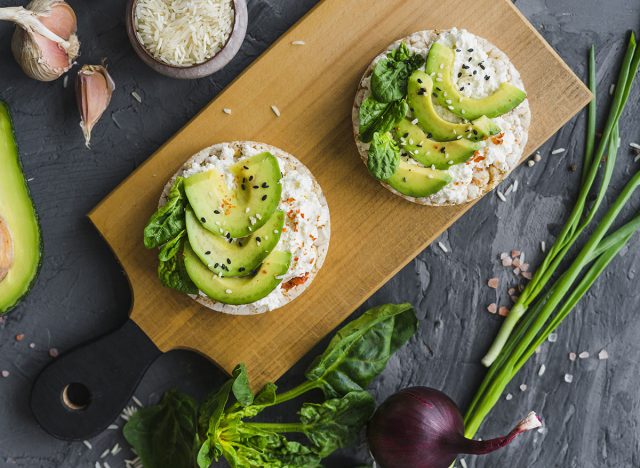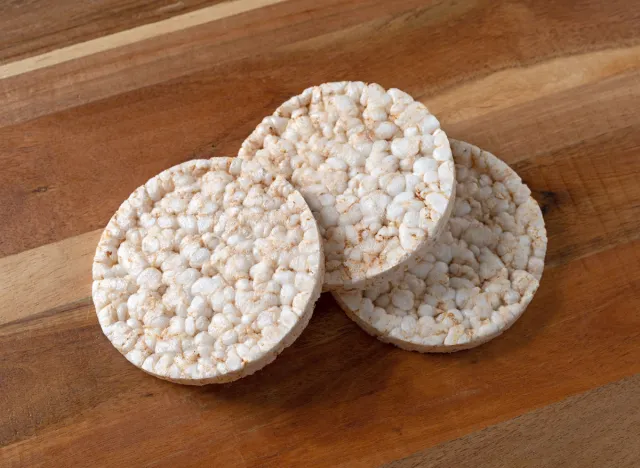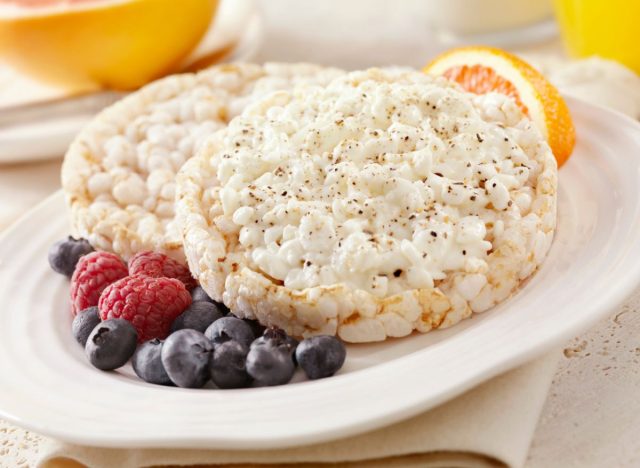Rice cakes have long been a go-to snack for crunch-loving dieters looking to cut calories. In 2020, nearly a million Americans consumed 8 or more bags of these diet-friendly carbohydrate snacks. It’s easy to see why—they’re a low-calorie alternative to bread, crackers, and chips, making them a convenient choice for health-conscious eaters. But before you start snacking, it’s important to consider whether rice cakes truly deserve their health halo.
In this article, we’ll explore the nutritional benefits and potential drawbacks of incorporating rice cakes into your diet and whether rice cakes are healthy.
Rice Cakes Nutrition

Incorporating rice cakes into your daily nutrition routine provides an energizing source of carbohydrates with little to no added sugar (depending upon flavor).
There are several flavors of rice cakes, such as lightly salted, buttered popcorn, white cheddar, chocolate, apple cinnamon, and caramel, with very little nutritional profile variations. According to the USDA, one plain unsalted standard rice cake contains:
Nutrition (Per 1 brown rice cake):
Calories: 35
Fat: 0 g (Saturated Fat: 0 g)
Sodium: 2 mg
Carbs: 7 g (Fiber: 0 g, Sugar: 0 g)
Protein: 0 g
Magnesium: 3% of RDA
Phosphorous: 4% of RDA
Zinc: 3% of RDA
Selenium: 3% of RDA
Rice cakes can be made using white or brown rice, requiring few additional ingredients beyond flavoring. According to Quaker, a portion of grains is added to a small pan. Heat is applied while a hot cylinder presses down onto the pan. The heat and pressure increase until the grains burst, causing them to pop into a woven pattern. The flavorings are then applied after the cakes are formed.
Benefits of Rice Cakes

1. They’re a low-energy-density carb source
Most people love lots of carbs. And since rice cakes are essentially filled with air, you can eat a larger portion with fewer calories. This is what’s called a low-energy-density food. Low-energy-density foods are ones that are low in fat, high in fiber, and low in calories. These foods can help you feel full despite eating fewer calories overall. This is important for someone trying to achieve or maintain a healthy body weight or on a restricted diet.
Research suggests reducing the energy density of foods in your diet is associated with weight loss without deliberately restricting calories.
2. They’re generally gluten-free
If you’re someone who restricts gluten for medical reasons, you know how difficult it can be to find low-cost foods that won’t aggravate your condition. Because rice is naturally gluten-free, rice cakes are, too. That makes them a widely available and convenient option for snacks and meals. If you have celiac disease or gluten sensitivity, you should read the label to be sure no gluten-containing ingredients have been added.
3. They’re usually made with whole grains
Most rice cakes are made with brown rice, a whole grain. Research suggests a diet rich in whole grains is associated with a reduced risk of obesity or weight gain, reduced risk of developing cardiovascular disease, like hypertension, coronary heart disease (CHD), and stroke, improved gut health, and reduced risk of certain cancers. Brown rice, in particular, is rich in antioxidants, helps balance blood sugar, and has cardio-protective properties, including improving cholesterol.
4. They’re easy to digest
Some people have a difficult time digesting certain foods that contain FODMAPs. FODMAPs are fermentable oligosaccharides, disaccharides, monosaccharides, and polyphenols. These short-chain carbohydrates move into the small intestine, where they’re consumed by gut bacteria, leading to uncomfortable bloating, gas, belly pain, and diarrhea. Brown rice and rice cakes are low in FODMAPs, making them more easily digested. Those who suffer from the symptoms associated with FODMAP foods should be able to safely consume rice cakes without distress.
5. They’re versatile, convenient, and cost-effective
Convenience is one of the most valuable aspects of food products these days. The need for quick yet nutritious options for people leading busy lives is paramount, and rice cakes fit the bill. They’re a portable carbohydrate source with only a few ingredients that can replace crackers, bread, chips, cereal, and other snacks. The average sleeve of rice cakes may cost anywhere from $1.79 to $6, depending upon the brand you choose and where you purchase. Even a sleeve of Quaker rice cakes at $3.14 means you’re looking at only $0.22 per rice cake. That’s pretty similar to the average cost of a loaf of bread.
Potential Downsides of Rice Cakes

1. They’re not very filling
A plate of rice cakes may be a less-than-filling snack. Since they’re just puffed rice and air, they lack the nutrients—protein, fiber, and fat—that will keep you feeling full and satisfied. And if you’re not satisfied after a meal of just carbs, studies show you’re more likely to overeat versus if you had incorporated water, fiber, and protein.
Since high-glycemic carbs like rice cakes digest quickly, they don’t stay in the stomach long, leading you to feel hungry shortly after. Research suggests diets or meals rich in high glycemic foods have low satiating effects. That means if you eat a lot of simple carbohydrate foods, you’re less likely to be full and satisfied and more likely to eat more than your body needs. This is dangerous for someone trying to maintain a healthy body weight.
2. Some flavors contain added sugar
While the amount of sugar in one rice cake isn’t anything to worry about, you’ll want to read the label carefully if you’re trying to limit added sugars. Certain flavors of rice cakes, including chocolate, apple cinnamon, and caramel, contain anywhere from 3-5 grams of added sugar for one cake. Eating three rice cakes in one serving means you’re looking at 9-15 grams of sugar. To put that into perspective, 15 grams of sugar is equivalent to one tablespoon of granulated sugar. The USDA Dietary Guidelines recommends limiting your sugar intake to no more than 10 teaspoons per day or 3.3 tablespoons. It’s clear those three rice cakes will take a big chunk out of your daily sugar goals.
3. They may raise your blood sugar
Rice cakes (by themselves) may not be the best choice for someone trying to balance their blood sugar. They’re generally low in fiber and high on the glycemic scale, which means they can spike blood sugar quickly. Inconsistent rapid blood sugar spikes followed by deep falls lead to tiredness, fatigue, and hunger, which will only lead you to eat more rice cakes.
If you have pre-diabetes, type 2 diabetes, or insulin resistance, pair rice cakes with protein, fiber, or fat to help flatten the blood sugar curve.
Are Rice Cakes Healthy?

Whether you choose to eat rice cakes should depend on whether you actually like them. There’s not enough nutritional value beyond being a fast and low-calorie carb source to give them superfood status. But a handful of redeeming qualities move them towards being a nutritious option. They’re a convenient and affordable snack food that’s easy to digest for those with celiac disease, a gluten-sensitivity, and irritable bowel syndrome (IBS), while providing a low-energy density food option for someone trying to maintain a healthy body weight. On the other hand, if you’re sitting down to a sleeve of rice cakes without pairing them with more nutrient-dense ingredients, they could raise your blood sugar and lead you to overeat later.
To make rice cakes even better, pair them with protein, fiber, or fat. This will help slow the rice cakes’ digestion, curbing blood sugar spikes while keeping you full and satisfied. Try one of these rice cake toppers the next time you’re craving a crunchy snack!
- Cottage cheese, everything bagel seasoning, and sliced tomato
- Almond butter and a drizzle of honey
- Tuna or egg salad
- Avocado and everything bagel seasoning
- Guacamole
- Cream cheese and smoked salmon
- Ricotta cheese, a drizzle of honey, and sliced strawberries
- Peanut butter and sliced banana or jelly
- Cream cheese, thinly sliced cucumber, and pepper jelly
- Hummus and sliced roasted red peppers
- Turkey and cheddar cheese








